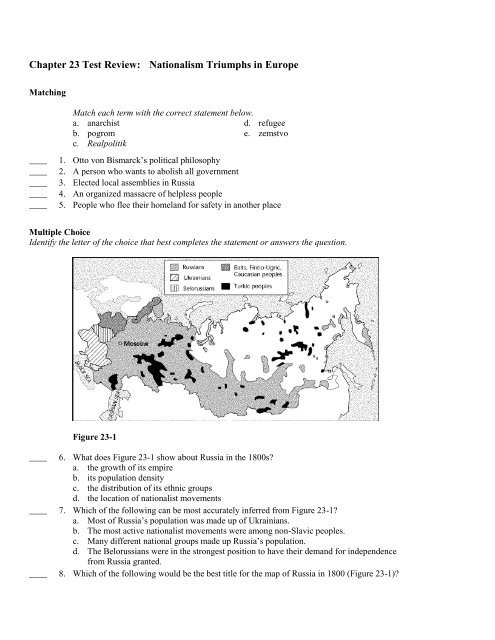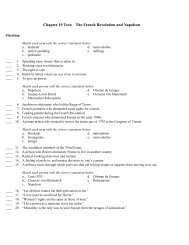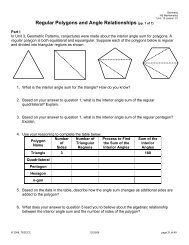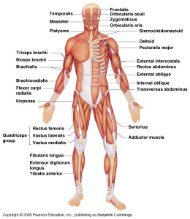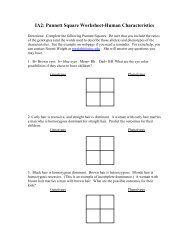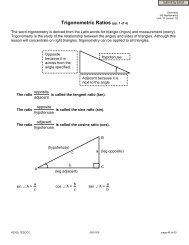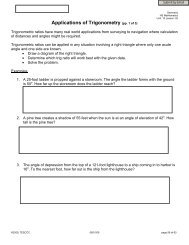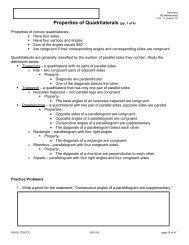Chapter 23 Test Review: Nationalism Triumphs in Europe
Chapter 23 Test Review: Nationalism Triumphs in Europe
Chapter 23 Test Review: Nationalism Triumphs in Europe
You also want an ePaper? Increase the reach of your titles
YUMPU automatically turns print PDFs into web optimized ePapers that Google loves.
<strong>Chapter</strong> <strong>23</strong> <strong>Test</strong> <strong>Review</strong>: <strong>Nationalism</strong> <strong>Triumphs</strong> <strong>in</strong> <strong>Europe</strong><br />
Match<strong>in</strong>g<br />
Match each term with the correct statement below.<br />
a. anarchist d. refugee<br />
b. pogrom e. zemstvo<br />
c. Realpolitik<br />
____ 1. Otto von Bismarck’s political philosophy<br />
____ 2. A person who wants to abolish all government<br />
____ 3. Elected local assemblies <strong>in</strong> Russia<br />
____ 4. An organized massacre of helpless people<br />
____ 5. People who flee their homeland for safety <strong>in</strong> another place<br />
Multiple Choice<br />
Identify the letter of the choice that best completes the statement or answers the question.<br />
Figure <strong>23</strong>-1<br />
____ 6. What does Figure <strong>23</strong>-1 show about Russia <strong>in</strong> the 1800s?<br />
a. the growth of its empire<br />
b. its population density<br />
c. the distribution of its ethnic groups<br />
d. the location of nationalist movements<br />
____ 7. Which of the follow<strong>in</strong>g can be most accurately <strong>in</strong>ferred from Figure <strong>23</strong>-1?<br />
a. Most of Russia’s population was made up of Ukra<strong>in</strong>ians.<br />
b. The most active nationalist movements were among non-Slavic peoples.<br />
c. Many different national groups made up Russia’s population.<br />
d. The Belorussians were <strong>in</strong> the strongest position to have their demand for <strong>in</strong>dependence<br />
from Russia granted.<br />
____ 8. Which of the follow<strong>in</strong>g would be the best title for the map of Russia <strong>in</strong> 1800 (Figure <strong>23</strong>-1)?
a. Population Density <strong>in</strong> Russia c. Nationalities of Russia<br />
b. The Growth of the Russian Empire d. Russian Expansion<br />
____ 9. Accord<strong>in</strong>g to Figure <strong>23</strong>-1, which of the follow<strong>in</strong>g statements is the most reasonable?<br />
a. Turkic peoples had the strongest argument <strong>in</strong> favor of <strong>in</strong>dependence.<br />
b. The Ukra<strong>in</strong>ians were treated the most harshly of any national group.<br />
c. Most of Moscow’s population <strong>in</strong> 1800 were Russians.<br />
d. Most nationalist revolts occurred <strong>in</strong> or around Moscow.<br />
____ 10. Otto von Bismarck was responsible for the<br />
a. creation of the Zollvere<strong>in</strong>. c. loss of the Franco-Prussian War.<br />
b. unification of Germany. d. rise of Napoleon III.<br />
____ 11. Which of the follow<strong>in</strong>g was a result of the Franco-Prussian War?<br />
a. Prussia defeated France. c. Austria defeated Prussia.<br />
b. France defeated Prussia. d. France defeated Austria.<br />
____ 12. Which of the follow<strong>in</strong>g contributed to Germany’s growth as an <strong>in</strong>dustrial power under Bismarck?<br />
a. tight state control over <strong>in</strong>dustry<br />
b. a large overseas empire<br />
c. substantial iron and coal reserves<br />
d. Prussia’s victory over the French <strong>in</strong> the Franco-Prussian War<br />
____ 13. The Kulturkampf refers to Bismarck’s attempt to<br />
a. encourage appreciation for the arts.<br />
b. destroy nationalist movements.<br />
c. discourage socialism.<br />
d. weaken the <strong>in</strong>fluence of the Catholic Church.<br />
____ 14. William II of Germany pursued a foreign policy aimed at<br />
a. destroy<strong>in</strong>g the French navy.<br />
b. prevent<strong>in</strong>g foreigners from com<strong>in</strong>g to Germany.<br />
c. w<strong>in</strong>n<strong>in</strong>g overseas colonies for Germany.<br />
d. encourag<strong>in</strong>g socialist revolutions <strong>in</strong> Africa and Asia.<br />
____ 15. Which of the follow<strong>in</strong>g made Italy hard to unite <strong>in</strong>to a s<strong>in</strong>gle country?<br />
a. lack of a common language c. lack of natural resources<br />
b. regional differences d. ethnic differences<br />
____ 16. A major threat to the Hapsburg empire came from<br />
a. nationalist demands. c. socialist reformers.<br />
b. the Ottoman empire. d. the French.<br />
____ 17. The revolution of 1905 broke out as a result of<br />
a. persecution of the Jews.<br />
b. the kill<strong>in</strong>g of demonstrators on Bloody Sunday.<br />
c. the free<strong>in</strong>g of the serfs.<br />
d. Napoleon’s <strong>in</strong>vasion of Russia.<br />
____ 18. Which of the follow<strong>in</strong>g happened LAST?<br />
a. Prussia ga<strong>in</strong>ed control of Schleswig. c. Prussia went to war with Austria.<br />
b. Prussia defeated France. d. Prussia created the Zollvere<strong>in</strong>.<br />
____ 19. How did the German government encourage economic development?<br />
a. It protected its <strong>in</strong>dustries from foreign competition.<br />
b. It subsidized <strong>in</strong>dustry.<br />
c. It owned and managed Germany’s <strong>in</strong>dustry.<br />
d. It prohibited the sale of foreign goods <strong>in</strong> Germany.<br />
____ 20. Under Bismarck, Germany took a pioneer<strong>in</strong>g role <strong>in</strong><br />
a. social and economic reform. c. socialist reform.
. political reform. d. judicial reform.<br />
____ 21. <strong>Nationalism</strong> posed the biggest threat to which of the follow<strong>in</strong>g?<br />
a. Prussia c. Germany<br />
b. Italy d. the Austrian empire<br />
____ 22. Which of the follow<strong>in</strong>g contributed most to the growth of nationalist movements <strong>in</strong> the Balkans <strong>in</strong> the<br />
mid-1800s?<br />
a. the decl<strong>in</strong>e of the Ottoman empire<br />
b. the spread of democracy<br />
c. competition between Brita<strong>in</strong> and France for the Balkans<br />
d. Germany’s grow<strong>in</strong>g power<br />
____ <strong>23</strong>. The revolution of 1905 led to<br />
a. democracy <strong>in</strong> Russia. c. the free<strong>in</strong>g of Russian serfs.<br />
b. m<strong>in</strong>or changes <strong>in</strong> Russia. d. equal vot<strong>in</strong>g rights for all citizens.<br />
Short Answer<br />
24. List five factors that helped German <strong>in</strong>dustry grow <strong>in</strong> the late 1800s.<br />
25. List three reforms that resulted from the revolution of 1905.
<strong>Chapter</strong> <strong>23</strong> <strong>Test</strong> <strong>Review</strong>: <strong>Nationalism</strong> <strong>Triumphs</strong> <strong>in</strong> <strong>Europe</strong><br />
Answer Section<br />
MATCHING<br />
1. ANS: C<br />
2. ANS: A<br />
3. ANS: E<br />
4. ANS: B<br />
5. ANS: D<br />
MULTIPLE CHOICE<br />
6. ANS: C<br />
7. ANS: C<br />
8. ANS: C<br />
9. ANS: C<br />
10. ANS: B<br />
11. ANS: A<br />
12. ANS: C<br />
13. ANS: D<br />
14. ANS: C<br />
15. ANS: B<br />
16. ANS: A<br />
17. ANS: B<br />
18. ANS: B<br />
19. ANS: A<br />
20. ANS: A<br />
21. ANS: D<br />
22. ANS: A<br />
<strong>23</strong>. ANS: B<br />
SHORT ANSWER<br />
24. ANS:<br />
Answers should <strong>in</strong>clude five of the follow<strong>in</strong>g: large deposits of coal and iron; a discipl<strong>in</strong>ed and educated work<br />
force; a huge home market; earlier progress <strong>in</strong> <strong>in</strong>dustries that had been established <strong>in</strong> the mid-1800s; scientific<br />
research and development; government support <strong>in</strong>clud<strong>in</strong>g organized bank<strong>in</strong>g, the development of a<br />
transportation <strong>in</strong>frastructure, and tariffs to protect home trade from foreign competition.<br />
25. ANS:<br />
The czar promised personal freedoms, <strong>in</strong>clud<strong>in</strong>g freedom of person, speech, and assembly, and the<br />
establishment of an elected national legislature. The prime m<strong>in</strong>ister enacted moderate land reforms. In the<br />
end, however, there was relatively little positive change for the peasants and the workers. Russia was still an<br />
autocracy.


